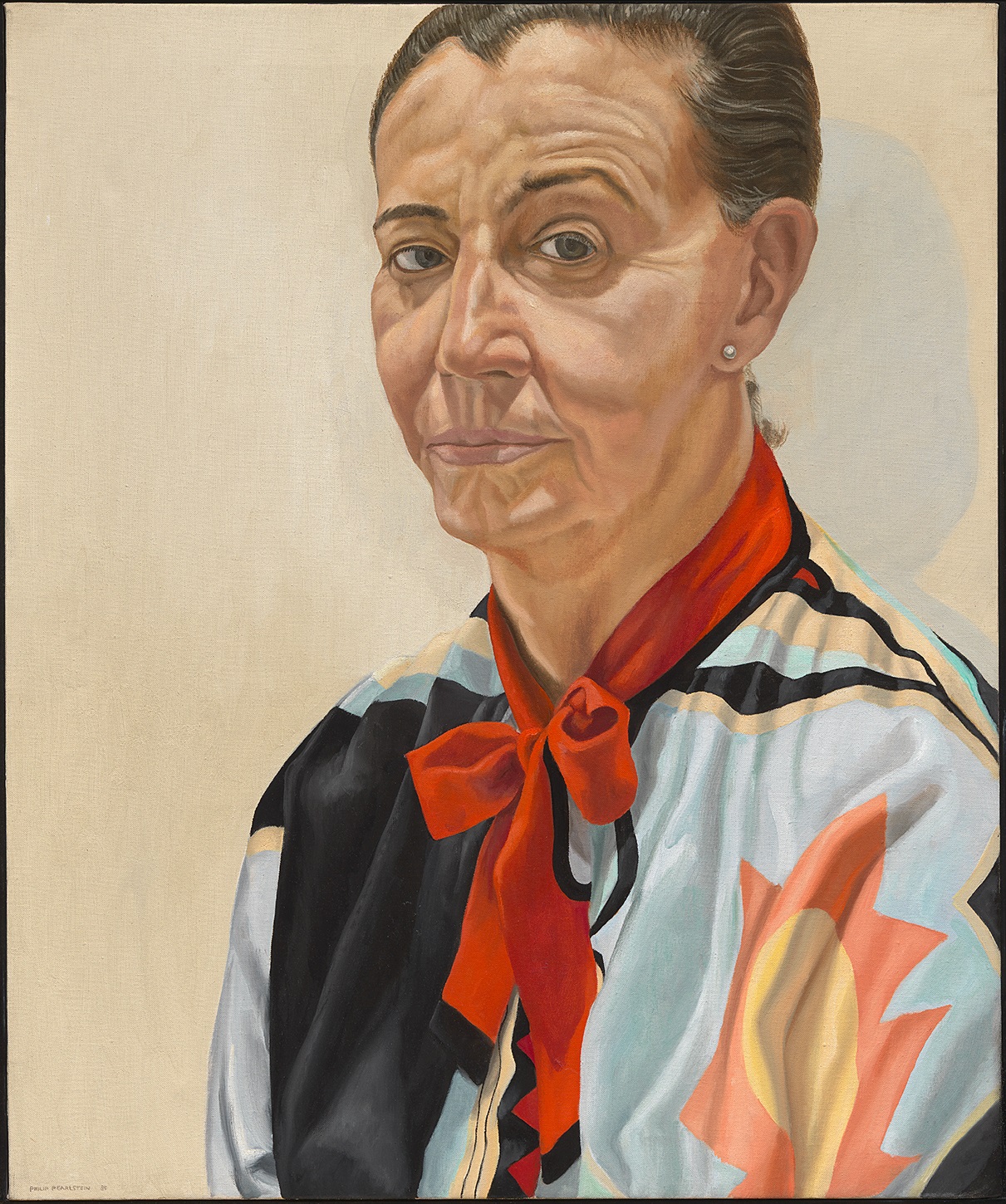
Brave, ingenious, and startlingly original, American shoe designer Beth Levine (1914-2006) seems also to have held generous doses of common sense and a ready wit. Looking at Philip Pearlstein’s mid-1980s portrait of her, one can’t help but feel this is someone you already know, or should know. As photographer Bruce Weber wrote in memory of Levine, “Beth spoke Yiddish as elegantly as she spoke French. She could sip her scotch and tell risqué jokes to royalty and truck drivers alike—in other words, ‘she was the life of the party.’ Her shoe designs were world famous, but what she loved most was that she was always a farm girl who knew a good tomato when she saw one.”
The National Portrait Gallery’s loan of Pearlstein’s painting was one of the essential starting points for our exhibition “Beth Levine: The First Lady of Shoes” (August 21, 2015-January 3, 2016). Pearlstein’s wife, Dorothy Cantor Pearlstein, was Levine’s first cousin and both of their respective families had immigrated to the United States from the same village in Lithuania. The artist has captured a real quiet strength and inimitable beauty in his depiction, one that also bespeaks a lifetime of friendship.
The painting is one of nearly 150 artifacts and works of art in the exhibition—many shoes, photographs, film clips, and more. Our guest curator, Helene Verin, a Fashion Institute of Technology (FIT) professor, author of Beth Levine Shoes (2009), and herself a former shoe designer “to boot,” was the perfect person to spearhead this effort. She also knew Beth personally, as she relates below.
-Joshua Ruff, Director of Collections and Interpretation, The Long Island Museum
When I moved to New York City in the late 1970s and decided to become a shoe designer, the reigning queen of that realm was Beth Levine. Although Herbert and Beth closed their factory in 1976, Beth remained active until her death in 2006. She became an enormous presence and influence to me as an inspirational mentor and friend.
The story of how Bessie Katz, growing up on a farm in Patchogue, Long Island, became one of the great designers of the twentieth century is a fascinating one. Intending to enroll at Pratt Institute, Beth moved to New York City in 1938. Needing a job and having size four feet (the sample size at the time), she worked as a shoe model. Consequently, she had outstanding intuition about how different styles fit.
In fashion design, American manufacturers have idolized and copied European designers (primarily from France and Italy). Fortunately, Beth was able to be as inventive and avant garde as she pleased. In 1946, she married Herbert Levine, whose name was on the company label (a woman’s name had never appeared on footwear before). Beth Levine became a legendary designer whose contributions changed the history of shoe design.
When Herbert and Beth Levine opened their factory in 1949, “Made in New York City” was synonymous with quality footwear. They hired Italian shoe lasters; Jewish stitchers from Poland, Hungary, and Romania; and Irish leather cutters. Their head of production, Tony Acuti, once said, “Here, everyone had to coddle the shoes, handle them, kiss them before they went into a box...—and then they look up and say ‘thank you.’”
As a shoe designer myself, I kept up a regular correspondence with Beth during my career. Upon my return to New York City in 1996, Beth and I reconnected. Stopping by for lunch three times a week, I began going through her archives and talking with her for hours about her accomplishments and the frustration of being a shoe designer with a new idea. Her love and knowledge of contemporary culture mirrored mine, and I found a great friend. Her apartment was full of books, art (Milton Avery, Philip Pearlstein, Pablo Picasso, Pierre Bonnard, Joseph Solman, Chaim Gross, and Theodore Bikel) great furniture, and, of course, shoes and boots from her private collection. I would giddily try on her couture clothes (Balenciaga, Halston, Geoffrey Beene, Adele Simpson, and Michael Vollbracht). We would eat her homemade chopped liver, laugh hysterically, and sometimes cry. Together we visited her factory storage in the basement of 161 Avenue of the Americas, and she gave me buckets of old samples, shoe ornaments, press cards, and other items. Later, I’d go home and wash the dust off the ornaments and try to imagine what Beth was thinking in sampling them.
So many mid-century women remain unknown for their amazing contributions. My students at FIT had never heard of Beth Levine which is why I felt compelled to tell her story. By writing Beth Levine Shoes and curating exhibitions about her, my intention is to keep Beth’s unique vision alive for generations to come.
Beth always said that the only mistake in design is “playing it safe.” She introduced revolutionary silhouettes in ingenious materials that were flawlessly comfortable. “Shoes off” to the most important American shoe designer of the twentieth century!
-Helene Verin, Curator of “Beth Levine: The First Lady of Shoes”